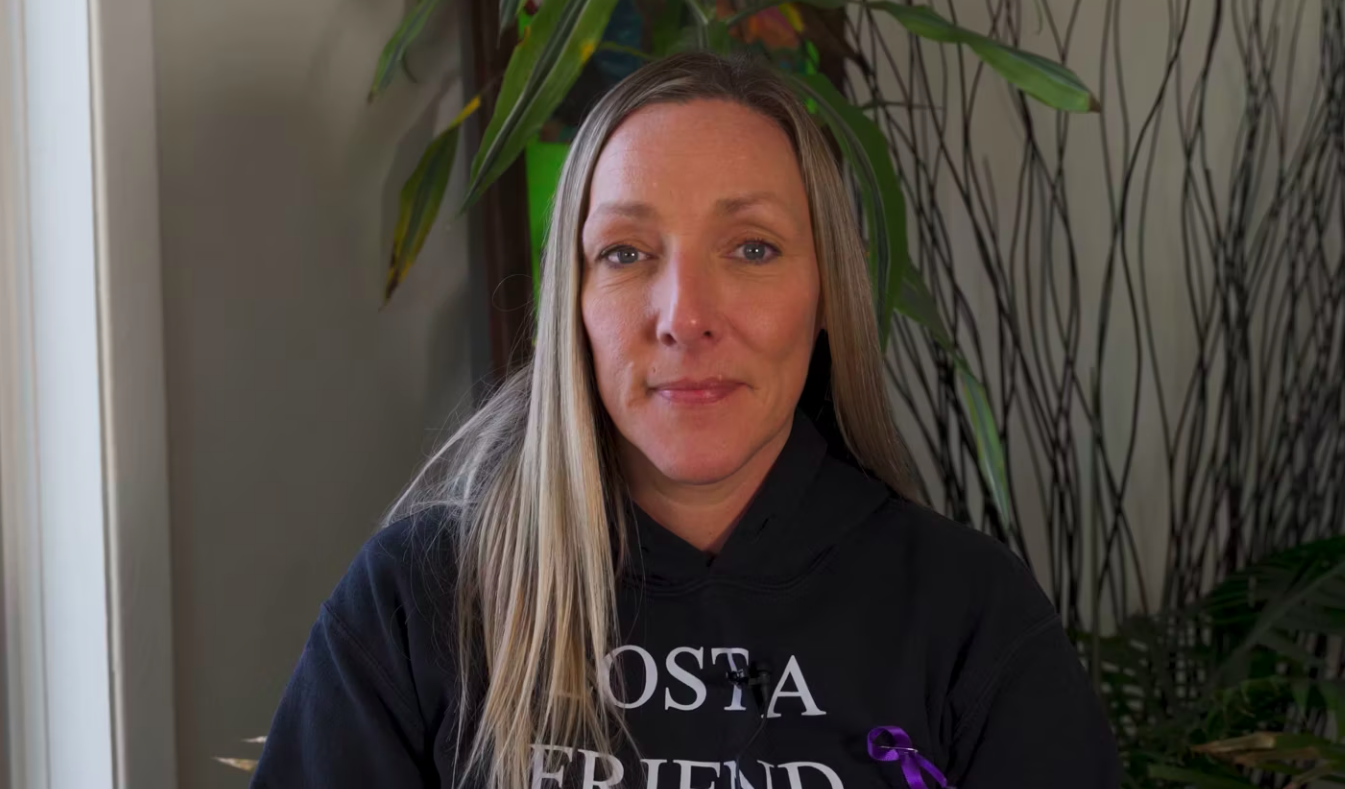Posts Tagged ‘supporting others’
Ripples of Grief: Supporting Ourselves, Others, and our Communities After a Death
By Jessica Milette, MSW, RSW
When death knocks on the door of a community, each of us are impacted. Sometimes a death will touch many lives across a community, whether people knew the deceased personally or not. We may grieve the death of a family member, friend, or acquaintance, a well-known community member, or someone we are linked to by age, location, circumstances, etc. Community grief can feel overwhelming – we must tend to our own grief, but others in our life are grieving and hurting too. Each person in a community will grieve differently depending on their relationship to the person who has died, their own prior experiences of loss, and the unique coping strategies they rely on in grief.
Developed by psychologist Susan Silk and Barry Goldman following Susan’s experience with a health crisis and her diagnosis with breast cancer, Ring Theory helps us learn how to support others and ourselves when a community death occurs.
Like a ripple on water when we drop a pebble into it, imagine a series of concentric circles. Those directly impacted by the crisis or death are in the innermost ring, with each outer ring consisting of those further removed from the crisis or death. Generally the immediate family, or those who lived with the deceased,are in the innermost ring, with close friends and other family in the next ring, co-workers and acquaintances in the next ring, and those in our greater community in the outer rings.
When someone experiences a death, those in outer rings pour comfort in, while those in inner rings are allowed to “dump” their thoughts or feelings out. When someone in an inner ring is dumping out their feelings, those in outer rings can show up with acceptance and care, listening and validating the person’s experiences.
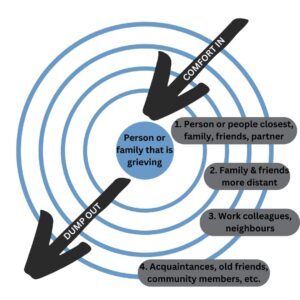
Pouring comfort in can also be the offer of specific, practical help. This approach seeks the griever’s consent to accept specific support and comfort, it lets the griever say yes or no to the offer, and can confirm what kinds of support are most helpful to them. It’s important to offer support on the griever’s terms.
When a community faces loss, many who are impacted want to share their feelings about the loss. Susan recalled during her cancer treatment how some folks she did not have very close relationships with in her community would show up unannounced, forcing her to accept support, or people would talk about their own feelings about her diagnosis. Dumping feelings onto someone in an inner circle is not helpful. It can leave those experiencing the loss most personally as if their loss is unacknowledged. When we know which ring we sit in after a death, we can connect to our own outer rings anytime we need to tend to our feelings of grief. If we find ourselves thinking about reaching out for support from someone who is in an inner circle compared to our relationship to the deceased, we should take a step back. Is there someone else that may be located in the same ring as us, or someone in a ring outside of us that we can reach out to instead? Sometimes actually drawing out the rings of folks in our own life impacted by a death can clarify where we need to support others, and who we can connect with for our own support.
Whether supporting others, or seeking support ourselves, a helpful phrase may be “Would you like to be heard, helped, or hugged?” Being heard means receiving supportive listening and validation. Being helped may mean brainstorming and collaborative problem-solving, or providing specific practical help with tasks. Sometimes there are no words or help we can offer, but, if welcome, our steady presence and a comforting hug can communicate our support.
Each person in a community will be impacted differently by a community death. It’s important to remember this theory about who we need to pour comfort into, and who we ourselves can dump out to as we navigate a community loss.
Articles Reviewed for Blog Post:
https://karenwulfson.com/wp-content/uploads/2013/04/How-not-to-say-the-wrong-thing1.pdf
https://www.latimes.com/opinion/op-ed/la-xpm-2013-apr-07-la-oe-0407-silk-ring-theory-20130407-story.html (actual article in LA Times first written by Susan Silk – first link is PDF version of same article)
https://www.psychologytoday.com/ca/blog/promoting-hope-preventing-suicide/201705/ring-theory-helps-us-bring-comfort-in
Nicole – Advice for Other Professionals Managing Grief
Nicole – Advice for Other Professionals Managing Grief
Nicole discusses dealing with repeated loss while working in community outreach, not being afraid to be human.
Alongside
By Mike Bonikowsky
Grief is the great leveller, and the great divider. Everyone grieves, sooner or later, but no two people will experience it in the same way. No two bereavements are the same, and neither are any two consolations.
This is only more poignantly the case for people with developmental disabilities. Not only is their grief completely unique, but they are often unable to express it in traditional ways. How are we to support someone through the grieving process when they cannot, or will not, tell us what they are thinking and feeling about their loss? The answer is simple, and difficult.
In Christian theology, there is a concept called “the Holy Spirit”. This is the invisible piece of God that is everywhere all the time, with and within all people. The name given to this in the original ancient Greek is the “Paraclete”, literally, “The one who comes alongside.”
That is also our best, and only role, when supporting a person with a developmental disability to grieve. We must be the one that comes alongside. There is no closer place we can get to. We must be present, be with, perhaps not understanding or comprehending what the person we support is experiencing, but alongside them nonetheless. We must be there, ready to provide whatever we can discover of their unique need in grief.
But that coming alongside must begin before the bereavement. We must already have been there through the happier seasons of the person’s life, if we are to know them well enough to read the language of their grieving, and hope to know in what little ways we may support them. Supporting a person with a developmental disability to grieve is not a matter of coming alongside, but of remaining where we already were. It is a matter of knowing and being known by them, of being trusted. It is not so much a matter of doing anything for the person, but of being something for them: A safe place, a consistent and reliable presence. It is to be a fixed point in a confusing, chaotic world, someone of whom they can say: “When that person is here, I can expect things to be like this.” Only when this relationship is present and well-established in the ordinary times can we come alongside in the darkest, loneliest season on the person’s life, and hope to meet their unspoken needs.
And usually the answer to those needs is what it has always been: To simply be there with them, to prepare a meal for them and do the dishes afterward, to help them wash body and find clean clothes to wear. To open the curtains in the morning, so that when they emerge from the dark cave of their unique grief, for however short a time, they are greeted by a world that has not ended, and a face that they know, and that knows them.
There One Day and Gone the Next : Art Therapy and Grief
By Sarah Smith DTATI, BFA
Over the last 12 years or so, I’ve had the opportunity to work with those grieving individually and in group settings, which has provided me with experience and insight into how art therapy (and art as therapy) can be beneficial to those dealing with loss.
What is Art Therapy?
“Art therapy combines the creative process and psychotherapy, facilitating self-exploration and understanding. Using imagery, colour and shape as part of this creative therapeutic process, thoughts and feelings can be expressed that would otherwise be difficult to articulate,”(CATA, 2022).
There’s no right or wrong in art therapy, it’s a matter of using the art as a vessel for wellness along side a trained professional. There are many benefits one can receive from engaging in the art making process such as: healthy coping strategies, insight, emotional stability/balance, stress /anxiety reduction, grounding of emotions, pleasure/joy, creativity, safe space, expression, control, freedom, and connection among many others!
Art Therapy and Grief
Grief is a very layered and challenging thing that is unique for each individual who experiences loss.
Because there is no “proper” way to grieve, art therapy can make for an excellent coping strategy as it allows for each person to express themselves in the way that’s best for them.
Unlike traditional “talk therapy”, art therapy has the art, so this means that one does not need to speak if they don’t want to or if they cant find the way to articulate how they feel into words. Sometimes, while people are grieving they cant even pin point how they feel and at other times the emotions can just be so overwhelming it can affect one physically and to try and talk about the emotions just exacerbates them.
Creating art in itself can be a healing thing. It can be a fun or relaxing thing to do. Engaging in an art therapy session can allow for so many more benefits. The art therapist can provide the participant with specific art therapy directives and art materials that they feel may be beneficial to your needs. Art therapists are trained to read and assess clients’ artwork. This means they may see things you may have missed that you might benefit from if brought to your attention. This insight makes it a great learning tool for self-discovery. We as art therapists believe that the art work holds the subconscious. What’s great about this for those who are grieving is that people can process however they need to. Some people need more time to process, some people need a more gentle approach where they feel in control, some people refuse to acknowledge things, and some people are just going through the motions and engaging in the art making process. The subconscious is purging and the healing is happening whether they realize it or not.
Art Therapy Directives (examples)
I facilitated a workshop at a hospice a couple years ago and offered it to those who had lost a loved one. The workshop began with a few art therapy warm-up exercises with the intention of helping everyone feel a bit more comfortable in the space and with each other.
The first art therapy directive I had them do was make flowers out of coffee filters, markers, and water. I wanted them to make something symbolic for their loved one. They began by writing whatever they wanted onto the coffee filters. Some people wrote the persons name, poems, a memory, or even drew a picture. They then watered down the filters and the colours began to bleed. Some people cried during this part. They could resonate with the symbolism. The water like tears. The bleeding of the colours representing pain, fuzzy memories, and a distant grasp on the person. When the coffee filters had dried we had turned them into flowers. The transformation of taking what we lost and carrying it forward in a new way was very powerful to witness and a very healing thing to say the least.
The second art therapy directive was focused more on the individual rather than the deceased. I gave everyone a mask. I instructed them to paint the front of the mask how they appear to the world and I asked them to create on the inside of the mask to show how they really feel or how they are actually doing (see figure 1).
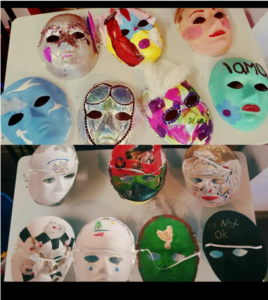
Figure 1.
They shared their art work from the workshop, but it was heavy. They were feeling sensitive and tired among other feelings so I had them sit and talk for a bit and then had them pull a self-care card for a distraction before letting them and drive home, as it may not have otherwise been safe for anyone overwhelmed after such an engaging session. This is typically how I run a grief workshop. Before they left the hospice asked them to fill out a score sheet to see how they felt about participating in the workshop and everyone said they liked it and for reasons, such as that they felt less anxious, they felt less alone, the felt lighter and more hopeful after the workshop.
At another hospice art therapy workshop, I had them create memory boxes. I provided them with a wooden box along with a variety of art materials, the only thing I asked was that they brought in a picture of the person they had lost. The purpose of this was to give them an opportunity to create something that could hold two energies, a place to honour them deceased, but also something tangible for them to have and hold. From my observations, I remember them taking a lot of time on these boxes and they were very quiet while making them. When they shared them, they were emotional, of course, but pride came through, it was like they made them for their people and wanted to make them well, so that their loved one would really like the box. This made them feel good for reasons such as honouring the person still while they are gone. Some people felt that their guilt had been eased a bit because they were physically doing something for that person who was no longer here. To see an example, see figure 2 and 2b.
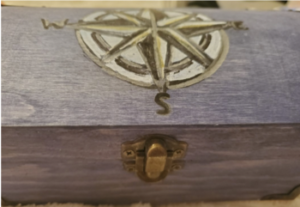
Figure 2
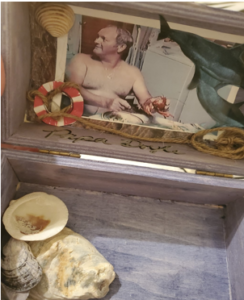
Figure 2b.
Following the memory boxes, I had them paint a step by step painting for their loved one. This was more of an art as therapy approach. This means they were literally using the art itself for wellness. They followed along with me and painted a whole painting. By following me, they were able to safely let go and get lost in the art making process. The intention was to enjoy the process while also giving them a healthy mental and emotional escape for however long it took us to paint the picture. I selected a picture of trees that had no leaves, purposely to symbolize letting go, loss, and reflection but the painting had an element of hope to it, the tress were pointing up to the sky, facing the light and there was lots of colour (see figure 3).
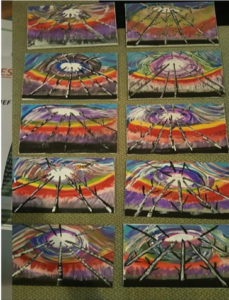
Figure 3.
The photos below are some examples of art from some of my sessions with clients around grief. They speak for themselves.
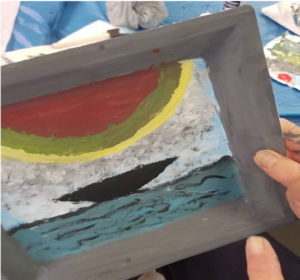
Figure 4.
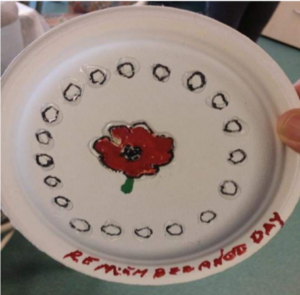
Figure 5.
Grief and Parenting in the Disability Community
By Carrie Batt, Grief Educator
Parenting is complicated as it has so many twists and turns. There are a variety of parenting styles such as hovering, free and easy, and everything in between. The one thing parents have in common is the fact that parenting never ends, thought it changes. Many parents can look forward to their child changing as they age and gain independence. Parents often look forward to and are proud of their child leaving the nest. Yet for many parents with children who have developmental disabilities, that is not the case. These parents must offer unwavering support, care, and guidance to their child or children who live with disabilities.
These are parents who are relied on in various ways, being the primary caregiver and managing everything. Some parents aging into their 70s, 80s, and 90s remain the sole primary caregiver to their child. Their day-to-day parenting tasks have never ended as their child has grown into adulthood. In fact, for some, their parenting roles increase as their child ages and may begin to lose daily living skills, develop early-stage dementia, show signs of aging or illness, begin to regress in specific areas or require much more support. Some parents must also cope with the fact that their child may be experiencing mental health issues in combination with a developmental disability. This is a most unique parenting experience as it is all-consuming. Such parenting speaks to a level of commitment and unconditional love where unwavering support is a constant.
In conjunction with these realities, there are times when such parents become a part of the end-of-life and palliative care communities. Once their child with a disability is diagnosed with a life-limiting illness, the only choice is to navigate end-of-life care, and there is no road map for what these parents will be embarking on. When it comes to death, dying and disability there is no education or expertise readily available. The same is true for grief, loss, and disability. Currently there are few disability-sensitive supports for such families who are having to transition from being the primary care giver to preparing for the impending death of their child.
The grief surrounding these realities have yet to be spoken of or integrated into the bereavement services and are rarely acknowledged within the developmental sector. The same is true of the reality faced when a child with a disability must face to mortality of their parents and primary caregivers, as for many of these children they may never have left the family home.
This is a type of grief most cannot imagine. This type of grief has not yet been recognized, validated, and honoured. There has been no space made within our grief support services that speaks of the magnitude of the grief surrounding these families. My hope is that the light can shine to meet these needs in the developmental sector for the families we serve.
Helping Others Help You Through Grief
Post by Maureen Pollard, MSW, RSW
When you’ve experienced the death of a loved one, one of the most difficult things you will go through is trying to find out what helps you adjust to the loss. This can be compounded when others around you don’t understand what you’re going through, and don’t know how to help you. Although you may not have much energy, and you may be reluctant to become a teacher, it may be just what your family and friends need to help you through your grief.
The concept of “pocket phrases” can be quite useful in helping others learn what you need as you grieve. These are statements that you practice ahead of time so that they come to you effortlessly in the moments when you are upset but still need to ask for someone’s help or understanding.
“That’s not helpful.” Usually, our friends and family are trying to help, however their actions may have the opposite effect. With practice, you can develop the ability to say this in a calm, confident voice that halts comments or behaviour that you find hurtful.
“Grief isn’t easy, but it is necessary.” Well-meaning people sometimes want us to move through grief quickly when that is just not possible. You can remind them that it’s normal to feel a full range of feelings after a loss and you don’t need to ‘cheer up’.
“I’m adapting. It takes time to adjust.” When someone in your circle of acquaintances asks how you’re doing, you can use this phrase to remind them that grief is a process. You can ask them directly to have patience with your intense feelings, the changes in your routines and at the same time let them know you’ll never be quite the same again.
“I’m not strong. I’m just doing what I must.” This phrase can be helpful when people praise your ability to function in routine tasks and situations. You may want them to understand that although you may look well on the outside, there’s still a whirlwind of emotion and distress raging unpredictably inside you.
“I like it when you say their name and we talk about them.” You can let people know they don’t have to be afraid to mention your loved one. If you want to share stories, and hear stories from others, you may need to give permission with a clear, direct statement such as this so that people aren’t afraid they will hurt you more by talking about them.
These sample statements can be a good starting point for developing your own useful “pocket phrases” to help teach the people in your life how to help you as you grieve. Remember that the more you practice the things you wish you could say, the easier it will become to pull them out in a peaceful and positive way when needed.
Sunny- The Importance of Friends While Grieving
Sunny- The Importance of Friends While Grieving
Sunny shares a story about receiving support from his close friends when he learned about his grandpa’s death while at a friend’s wedding.
Sunny- “It gets better”
Sunny- “It gets better”
Sunny shares how he found connecting with friends and family supportive while he was grieving.
Sunny- Supporting My Grieving Mom
Sunny- Supporting My Grieving Mom
Sunny talks about supporting his mom while she grieved the loss of her dad and the impact that had on his own experience of grief.
Donna B – “Seeking Help”
Donna B – “Seeking Help”
Donna talks about the importance of speaking to someone. Donna continues to grieve the death her son during service in Afghanistan.


